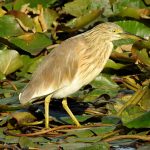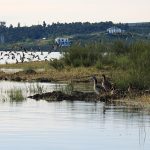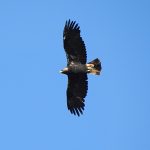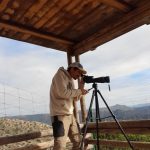Badajoz dam is one of the few urban areas considered as a SPA zone. If you want to spend a day of birdwatching in Badajoz, in the following post you will find some of the keys to make the most of it.
Main species, birdwatching in Badajoz
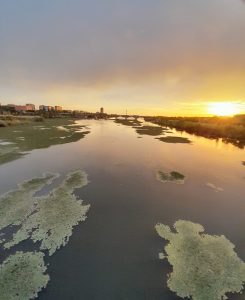
The Guadiana River as it passes through Badajoz has a series of special characteristics that make it an excellent area for birdlife. Along the riverbed there are several islands, which are used as roosts by thousands of birds. Birds that need more tranquility to roost use the islands farther away from the urban center. However, there are many that seem to be barely affected by light pollution and can roost perfectly well, practically in the “center of the city”.
In addition to these islands, the presence of common water hyacinth and Mexican water lily could even be considered positive for some bird species. Despite being invasive plant species and generally negative for the river ecosystem, they offer many bird species a surface on which to rest or feed. The banks are fairly well preserved, despite being in an urban area. There is a good density of riparian vegetation where birds also find refuge and a resting area.
Large waterfowl
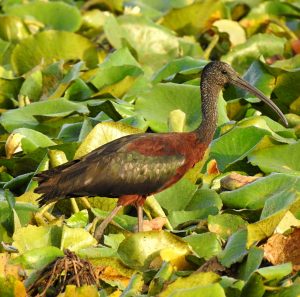
We found a very interesting representation of practically all groups of birds associated with the aquatic environment. In ducks the mallard is the most abundant species, but we can also find grebes and other species of ducks. As for ardeids we have interesting populations of egrets, cattle egrets, night herons, grey herons…. Rare species such as the purple heron, great egret, squacco heron, or bittern can even be sighted with some frequency.
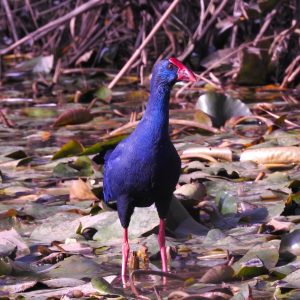
It is worth mentioning a very important population of Glossy ibis, birds that have conquered practically the entire Guadiana basin in recent years. To be located on any of the bridges at sunset, to see the flocks of Glossy ibis passing towards the roost, is one of the most interesting moments to do birdwatching in Badajoz. Spoonbills, although not as abundant, are also very interesting. The cormorant is also very abundant, both in the area of Badajoz and throughout the community. Raptors associated with the aquatic environment such as the marsh harrier or the osprey can be seen sporadically along this stretch of the Guadiana, although they tend to prefer quieter areas.
There are also good populations of gulls, both common and black-headed along this stretch of the river and a few hundred coots. Finally, as for “large” birds, we could highlight the Purple swamp-hen, a bird that not so long ago was in serious danger and that with its striking colors contributes to the beauty of the area.
Small waterfowl
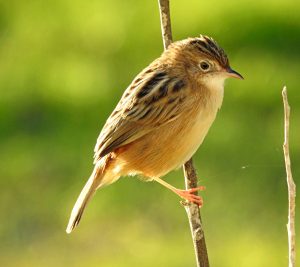
Here we will also include not only the waterfowl themselves, but also all the birds related to fluvial environment. The common moorhen is one of the most abundant species in the area, and can be found practically all along the river. The little bittern is also quite abundant, as well as the small kingfisher.
Population of passerines is also very rich and varied: from the Zitting zisticola to other larger birds such as warblers and wagtails. It is worth mentioning populations of exotic birds that are not native to the peninsula such as waxbill, red avadavat, weaver, common bishops, zebra finch… Regarding the group of waders we can find several species of plovers, sandpipers or stints.
Other interesting wildlife
Although birds are the main attraction of this area, it is also worth mentioning the presence of other groups of fauna. The otter is one of the most remarkable mammals that we can observe while birdwatching in Badajoz. In the grasslands of the floodplains we can occasionally observe hares, rabbits or even foxes at dusk or dawn.
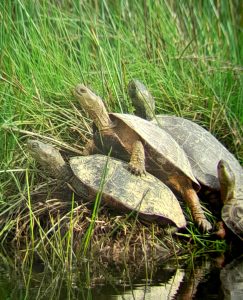
As for reptiles, there are several species of snakes, among which the necklace snake and viperine snake stand out. There are rocky areas near the river, where we can observe several species of lizards. On the bridges there are many geckos (I forgot to mention that they are also breeding grounds for the Alpine swift) and of course we can find pond turtles, mainly European. As exotic species we can also observe Florida tortoises, coming from not very responsible releases of people who got “tired” of having them at home.
Tips, birdwatching in Badajoz
Being an urban area, the birds are quite accustomed to human presence so we can do most of our birding on foot. Of course, as soon as we leave the usual paths, the birds will notice us and will move away from our positions. I recommend you not to leave the paths too much so as not to cause them too much disturbance.
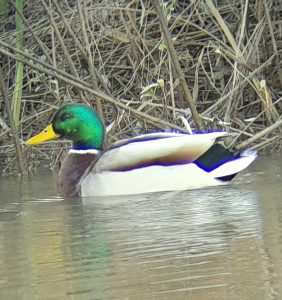
Another option that can be interesting is to hide among the vegetation on the shore. We can take a seat, plant our spotting scope, and remain stationary in the shallows. This other option can be a bit more tedious because we will have to wait for the birds to enter our area, but it can allow us to observe them more closely and without disturbing them.
I hope you find these tips useful and always remember to disturb the birds as little as possible so that they can continue with their normal activity.

